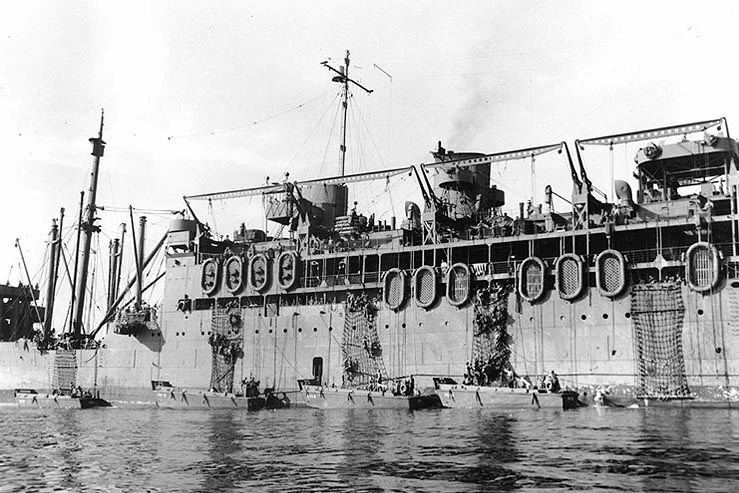 | ||
A troopship (also troop ship or troop transport or trooper) is a ship used to carry soldiers, either in peacetime or wartime. Operationally, standard troopships – often drafted from commercial shipping fleets – cannot land troops directly on shore, typically loading and unloading at a seaport or onto smaller vessels, either tenders or barges.
Contents
Attack transports, a variant of ocean-going troopship adapted to transporting invasion forces ashore, carry their own fleet of landing craft. Landing ships beach themselves and bring their troops directly ashore.
History
Ships to transport troops were already used in Antiquity. Ancient Rome used the navis lusoria, a small vessel powered by rowers and sail, to move soldiers on the Rhine and Danube.
The modern troopship has as long a history as passenger ships do, as most maritime nations enlisted their support in military operations (either by leasing the vessels or by impressing them into service) when their normal naval forces were deemed insufficient for the task. In the 19th century, navies frequently chartered civilian ocean liners, and from the start of the 20th century painted them gray and added a degree of armament; their speed, originally intended to minimize passage time for civilian user, proved valuable for outrunning submarines and enemy surface cruisers in war. HMT Olympic even rammed and sank a U-boat during one of its wartime crossings. Individual liners capable of exceptionally high speed transited without escorts; smaller or older liners with poorer performance were protected by operating in convoys.
Most major naval powers in the late 19th and early 20th centuries provided their domestic passenger lines with subsidies to ensure ships capable of transporting troops would be available during wartime. The British government aided both Cunard and the White Star Line to construct the liners RMS Mauretania, RMS Aquitania, RMS Olympic, RMS Britannic. When the vulnerability of these ships to return fire was realized most were used instead as troopship or hospital ships.
RMS Queen Mary and RMS Queen Elizabeth were two of the most famous converted liners of World War II. When they were fully converted, each could carry well over 10,000 troops per trip. Queen Mary holds the all-time record, with 15,740 troops on a single passage in late July 1943, transporting a staggering 765,429 military personnel during the war.
World War II
Large numbers of troopships were employed during World War II, including 220 "Limited Capacity" Liberty ship conversions, 30 Type C4 ship-based General G. O. Squier-class, a class of 84 Victory ship conversions, and a small number of Type-C3-S-A2 ship-based dedicated transports, and 15 classes of attack transports, of which some 400 alone were built.
Designation
The designation HMT (Hired Military Transport) would normally replace RMS (Royal Mail Ship), MV (Motor Vessel) or SS (Steamship) for ships converted to troopship duty with the United Kingdom's Royal Navy. The United States used two designations: WSA for troopships operated by the War Shipping Administration using Merchant Marine crews, and USS (United States Ship) for vessels accepted into and operated by the United States Navy. Initially troopships adapted as attack transports were designated AP; starting in 1942 keel-up attack transports received the designation APA.
Post WW II
In the era of the Cold War the United States designed the SS United States so that it could easily be converted from a liner to a troopship, in case of war. More recently, RMS Queen Elizabeth 2 and the SS Canberra were requisitioned by the Royal Navy to carry British soldiers to the Falklands War. By the end of the twentieth century, nearly all long-distance personnel transfer was done by airlift in military transport aircraft.
